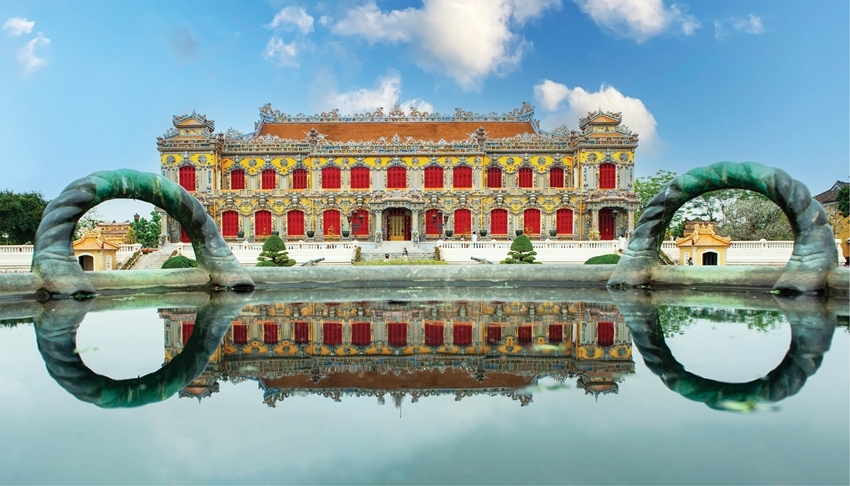 |
| Kien Trung Pavilion. Photo: Le Huy |
With the naked eye, one can clearly see the meticulous craftsmanship, delicate artistry, and skillful brushstrokes flowing gracefully along with the pinnacle technique of red lacquer and gold gilding that can be admired on every decorative detail - from the wooden pillars to the imperial canopy and the throne pedestal inside the palace. Standing in this space evokes a sense of emotion: the faint scent of lacquer and gold gilding still lingers, the admiration of the visitors saying “This truly deserves to be a symbolic masterpiece and the pride for Hue heritage in particular and for Vietnam as a whole.”
We have returned here many times since Thai Hoa Palace reopened for visitors. Many domestic and international tourists are “frozen in awe” upon entering this space. The majestic and beautiful architectural work, which has stood for over 200 years and faced the ravages of time, weather, and war, has now been fully revived.
The completion of the restoration of Thai Hoa Palace once again demonstrates the dedication and expertise of the current generation in preserving the heritage values left by their ancestors. The journey to preserve these timeless values for future generations does not stop here but continues, offering hope for the revival of other significant structures within Hue Imperial Citadel. One notable example is the Can Chanh Palace, which has just begun its initial restoration phase.
On the inauguration day of Thai Hoa Palace and the official recognition ceremony of Cuu Dinh, the Nine Dynasty Urns, as a UNESCO Documentary Heritage, in the presence of numerous international and domestic guests, Mr. Hoang Viet Trung - Director of the Hue Monuments Conservation Center - was moved as he recounted the three-year restoration project journey (completed nine months ahead of schedule) for this essential palace.
Mr. Trung recalled an idea expressed by Nguyen Khoa Diem (poet, former Politburo member and Head of the Central Ideology and Culture Commission) 20 years ago. At that time, Nguyen Khoa Diem shared a powerful observation about the heritage conservation efforts in Hue, roughly stating: 'Every day, we witness craftsmen who, despite the sun and rain, toil relentlessly to reclaim from the gods of rain, wind, thunder, and lightning every square centimeter of heritage in the ancient capital.”
Recalling this highlights that in the current heritage conservation efforts in Hue, the craftsmen and artisans on-site remain the direct contributors. They represent the present in a “dialogue with the past”, striving to restore the true values that time, weather, and natural disasters have worn down and destroyed.
With substantial resources and decades of effort, Hue’s heritage restoration and conservation have achieved remarkable successes, transitioning from emergency rescue to sustainable development. From this foundation, strategic cultural and economic initiatives have been implemented, positioning Hue as a centrally governed municipality and Vietnam first cultural and heritage city.
Before the restoration of Thai Hoa Palace, many other structures within the Complex of Hue Monuments had already been spectacularly revived. Notable examples along the sacred axis of the Imperial City include the Ngu Phung Pavilion and Kien Trung Palace. Upcoming projects include the restoration of Can Chanh Palace and, not far behind, the Dai Cung Gate. These efforts have given the complex a renewed appearance, affirming the determination of Hue authorities and residents in a region with the most UNESCO-recognized heritage sites in Vietnam - with eight of them in total.
In front of representatives from the Government, UNESCO, and numerous guests and experts both domestic and international, Mr. Nguyen Van Phuong, who was then the Deputy Secretary of the Provincial Party Committee and Chairman of the Provincial People's Committee, emphasized that the locality would continue to implement comprehensive and effective international and national action plans for heritage conservation and promotion. Accompanying these efforts are concrete solutions, both immediate and long-term, to breathe new life into the heritage, ensuring its eternity and greater contribution to the socio-economic development of the region.
Mr. Jonathan Wallace Baker, Head of Representatives of UNESCO in Vietnam, recalled the moment 30 years ago when UNESCO and the global community recognized the urgent need to collaborate with Vietnam, particularly Hue, to protect these invaluable heritage sites. Over that time, the efforts to preserve and revive the heritage have yielded many commendable achievements.
The UNESCO’s Head of Representative in Vietnam also emphasized that numerous challenges still lie ahead for both UNESCO and Vietnam in heritage conservation, restoration, and preservation in their original state. A crucial issue is enhancing preparedness to cope with the impacts of climate change, enabling the world's heritage sites to better recover from human-induced disasters or natural calamities while optimizing the well-being of local communities. Achieving these goals requires active participation from the community, including youth and women living around these heritage sites.